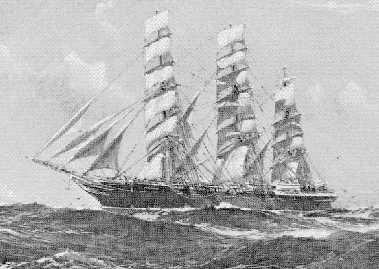 |
FAMOUS SHIPS |
 |
FAMOUS SHIPS |
THE "CROMDALE "
The CROMDALE was launched from Barclay, Curle & Co.'s yard on the Clyde in June 1891. Her measurements were: Tonnage, 1,903; length, 271 feet 6 inches; breadth, 40 feet I inch; and depth, 23 feet 4 inches. Her owners were Messrs. Donaldson, Rose & Co., who put her into the Sydney trade under Captain E. H. Andrews.
She very nearly ended her career on her first voyage, as she was involved in being embayed in a vast island of ice. This is a rare occurrence, but has happened three times in the last I 00 years or so. The weather conditions are such that very large chunks of the ice barrier bordering the continent of the South Pole break off. Ships have been known to be trapped in this ice and lost with all hands. Such an event took place in 1892-3, were some ships reported the ice to be hundreds of miles long and up to 1,500 feet in height just off the Horn.
Captain Andrews's account is as follows:
"We left Sydney on 1st March (1892), and having run our easting down on the parallel of 49 degrees to 50 degrees S., rounded the Horn on 30t" March, without having seen ice, the average temperature of the water being 43 degrees during the whole run across. At midnight on I" April, in 56 degrees S., 58 degrees 32 minutes W., the temperature fell to 37.5 degrees, this being the lowest for the voyage, but no ice was seen, though there was a suspicious glare to the southward.
"At 4 a.m. on 6"' April, in 46 degrees S., 36 degrees W., a large berg was reported right ahead, just giving us time to clear it. At 4:30, with the first signs of daybreak, several could be distinctly seen to windward, the wind being N.W., and the ship steering N.E. about 9 knots. At daylight, 5:20 a.m., the whole horizon to windward was a complete mass of bergs of enormous size, with an unbroken wall at the back; there was also many to leeward.

"I now called all hands, and after reducing speed to 7 knots, sent the hands to their stations and stood on. At 7 a.m. there was a wall extending from a point on the lee bow to about 4 points on the lee quarter, and at 7:' )O both walls joined ahead. I sent the chief mate aloft with a pair of glasses to find a passage out, but he reported from the topgallant yard that ice was unbroken ahead. Finding myself embayed and closely beset with innumerable bergs of all shapes, I decided to tack and try and get out the way I had come into the bay.
"The cliffs were now truly grand, rising up 300 feet on either side of us, and as square and true at the edge as if just out of a joiner's shop, with the sea breaking right over the southern cliff and whirling away in a cloud of spray. Tacked ship at 7:30,
finding the utmost difficulty in keeping clear of the huge pieces strewn so thickly in the water and having on several occasions to scrape her along one to keep clear of the next.
"We stood on in this way until II a.m., when, to my horror, the wind started to veer with every squall till I drew quite close to the southern barrier, having the extreme point a little on my lee bow. I felt sure we must go ashore without a chance of saving ourselves. Just about 11:30 the wind shifted to S.W., with a strong squall, so we squared away to the N.W., and came past the same bergs we had seen at daybreak, the largest being about 1,000 feet high, anvil-shaped. At 2 p.m. we got on the N.W. side of the northern arm of the horseshoe-shaped mass. It then reached from 4 points on my lee bow to as far as could be seen astern in one unbroken line.
"A fact worthy of notice was that at least 50 of the bergs in the bay were perfectly black, which was to be accounted for by the temperature of the water being 51 degrees, which had turned many over. I also think that had there been even the smallest outlet at the eastern side of this mass, the water between the barriers would not have been so thickly strewn bergs, as the prevailing westerly gales would have driven them through and separated them. I have frequently seen ice down south, but never any-thing like even the smaller bergs in this group."
This was the most exciting experience in CROMDALE's career. Her best passage was made in 1894, when she arrived off Prawle Point on April I 0'1', 80 days out of Sydney. In 1898 Captain Sibley took over the command. Her last commander, Captain Authur, of Dundee, took over command in 1913. On her return voyage she was wreaked off the Lizard in a very dense fog.